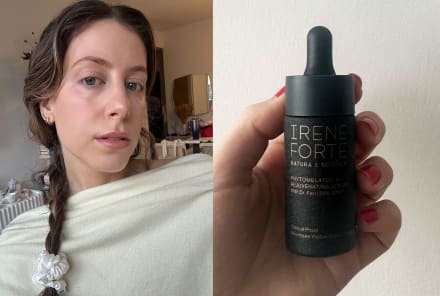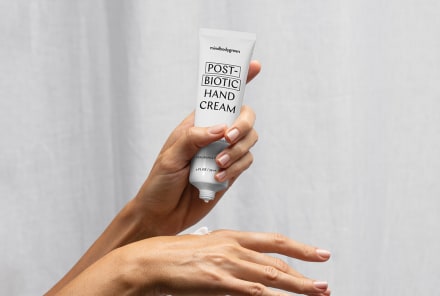Advertisement
Mineral Versus Chemical Sunscreen: What To Know About SPF + Pros & Cons


You know you need to apply sunscreen, sure. You may even know how much you need to apply (about a shot-glass worth) and how often you should do it (about every two hours). But do you know what type of SPF you should be using—or that there are even two very distinct categories of SPF?
Well, if that last point stumped you, you've come to the right place. Let us explain the world of mineral and chemical sunscreens, how they work, and the various pros and cons.
What is mineral sunscreen?
Mineral sunscreens are SPFs that manually block the sun and UV rays by creating a barrier on the skin. Think of them like a reflecting plane of glass: some of the rays hit the SPF and bounce off, shielding the skin below from damage. The two ingredients used to create a physical sunscreen are zinc oxide and titanium dioxide.
"Zinc oxide is a mineral that reflects light, including longer wavelength UVA, from the skin's surface," says board-certified dermatologist Loretta Ciraldo, M.D., FAAD. "It is one of only two mineral (also referred to as "non-chemical" or "inorganic") sunscreen active ingredients, but it is the only one that is effective at blocking UVA since titanium dioxide doesn't effectively block UVA."
But as author and chemist George Zaidan explains, mineral sunscreens also do some absorbing—like like their chemical counterparts. Essentially, they work in two ways: First by blocking some rays, and second by absorbing the rays and deflecting their damage by turning it into heat.
What is chemical sunscreen?
Chemical sunscreens—like those with active ingredients like oxybenzone, octinoxate, octisalate, and avobenzone—work by absorbing the UV rays, triggering a chemical reaction, which then transforms the UV into heat. Chemical sunscreens come in more variety, and so they tend to show up in more products.
Pros & cons of mineral sunscreen.
Let's weigh our options, shall we? We'll start with mineral:
Pro: Safest for skin and environment.
At the moment, zinc oxide and titanium dioxide are the only two ingredients the Environmental Working Group has deemed safe for use and effective at protecting the skin from UV damage. And as long as the minerals are non-nano (read: aren't broken down into smaller bits), they are deemed safe for oceans as research shows they don't cause coral bleaching or affect marine life.
For the non-nano part, be weary of micronized zinc as these are able to be ingested by marine life, and potentially causing harm.
Con: Many leave a white cast.
"It does make a white cast on the skin, and it makes the SPF thick in consistency," says Ciraldo. This is a notable issue for many, especially darker skin tones. Given that we should be wearing SPF daily, a thick, foggy film on the skin every single day is a nonstarter for many (rightfully so).
Many brands are, we should note, getting better at masking the white cast and making it blend in easier. So it may take some testing around, but you may just find the right option for you. (We also did the work and found options for any skin tone that you can check out here.)
Pro: Helps with reactive skin.
"Zinc oxide is arguably the most skin-calming of all the active sunscreen ingredients," says Ciraldo, which can help with sensitive and acne-prone skin. It's also noncomedogenic, so it won't clog pores and cause acne.
Pros & cons of chemical sunscreen.
Now, let's go through the advantages and drawbacks of chemical formulas.
Con: Some have been shown to cause coral bleaching.
There's a reason some countries and even U.S. states have banned oxybenzone and octinoxate: They have been shown to cause coral bleaching (or lightening of the coral's usual vivid colors) as well as pose a significant danger to marine life.
Pro: Easier to formulate with and more sensorially appealing.
These ingredients are usually thinner, spread easier, and formulate better with other skin care ingredients. Because of this, they are very commercially popular in traditional sunscreens.
Con: Absorbs deeper into skin and can be allergens.
Studies continue to show that many of these ingredients—oxybenzone and avobenzone, in particular—absorb into the bloodstream1, even after one use. Researchers generally haven't come to a consensus on what they do once they are absorbed, but perhaps best to skip until we know.
Experts agree: "Try to avoid the sunscreen ingredients oxybenzone and octinoxate. They are significant skin allergens and have been shown to have some estrogen-mimicking effects on the body2," physician Sarah Villafranco, M.D., writes about ingredients to avoid.
So which should you use?
The best sunscreen is one that you'll wear. Ultimately, protecting your skin from the affects of the sun is the most important factor here.
However, given the absorption and environmental concerns around chemical sunscreens, we suggest opting for mineral. Sure, there aren't as many, may be harder to rub in, and some options are pretty thick, but their safety profile (both for skin and the environment) makes them the best bet.
And formulas are only getting more sophisticated with time: In fact, you can find more than a few solid options on the market, with emollients and tints to help with spreadability and wear.
However, if your favorite sunscreen is a chemical number, we'd rather you wear that than nothing at all.
We should caveat: It's also OK to have a sunscreen wardrobe. Let's say you want a sheer face lotion for day-to-day (understandable), that doesn't mean you can't also have a mineral body option to slather on when you're at the beach. This isn't an all-or-nothing scenario.
The takeaway.
There are two main categories of SPF, mineral and chemical. For environmental and skin health reasons, we tend to recommend mineral when possible. However, given that they can be quite thick, we understand that many people don't find them sensorially or visually appealing. So ultimately, we think people should buy whatever sunscreen they will actually wear. For more intel, check out our guide to smart sun care and our favorite natural sunscreens and moisturizers with SPF.
Watch Next
Enjoy some of our favorite clips from classes
Enjoy some of our favorite clips from classes
What Is Meditation?
Mindfulness/Spirituality | Light Watkins
Box Breathing
Mindfulness/Spirituality | Gwen Dittmar
What Breathwork Can Address
Mindfulness/Spirituality | Gwen Dittmar
The 8 Limbs of Yoga - What is Asana?
Yoga | Caley Alyssa
Two Standing Postures to Open Up Tight Hips
Yoga | Caley Alyssa
How Plants Can Optimize Athletic Performance
Nutrition | Rich Roll
What to Eat Before a Workout
Nutrition | Rich Roll
How Ayurveda Helps Us Navigate Modern Life
Nutrition | Sahara Rose
Messages About Love & Relationships
Love & Relationships | Esther Perel
Love Languages
Love & Relationships | Esther Perel

















